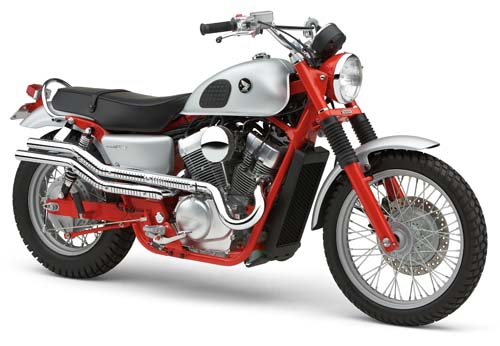
Nice restoration, right, a classic old Honda Scrambler. Oops, hold on a second—isn’t that a surprisingly stock 2010-model Shadow RS750 V-twin beneath the 1960s facade? Yeah, so what’s this then, a concept Honda retro-bike, a preproduction prototype meant to gauge public reaction before getting the green light and firing up the assembly lines?
Nope. Just a nicely done custom built by one man in about four months—never mind that Honda could do lots worse than have a model like this in their lineup.
It helps that the builder involved is the talented Denny Berg, chief (well, only) fabricator for the Cobra Engineering Special Projects Division, charged with crafting showbikes that will help the aftermarket exhaust-pipe and accessories maker stand out from the crowd. By loose count this is Berg’s 30th bike for Cobra in 15 years. Virtually all have been true one-off specials with few, if any, catalog parts bolted on, an enlightened approach intended to generate excitement, ink and goodwill for the company (cobrausa.com).
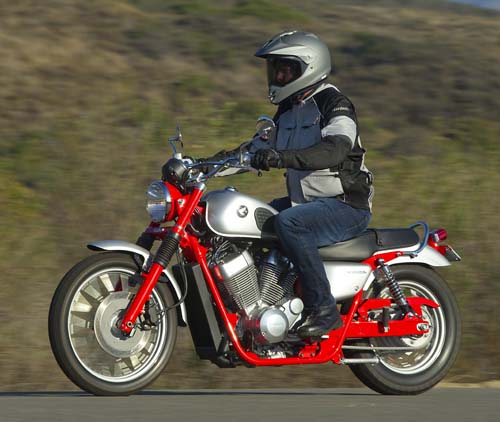
What type of custom to build for the upcoming show season is always a question. Some years it’s easy. When neo-choppers were all the rage, for instance, Berg built long bikes, as outrageous as anybody’s. Not appropriate today, when money is tight and tastes run to simpler, more useable machines. Honda’s introduction of the RS750 started the wheels turning in a new direction. Here was a bargain-priced V-twin different from the other Shadow 750s, roadster-styled and with chain final drive, “Honda’s Sportster,” a blank canvas crying out for a little customization. For direction, Berg turned back the clock to his teenage years when a hand-me-down CL77 Scrambler 305—its front end rearranged from an unfortunate encounter with a pickup truck’s tailgate—had been an early modification project.
Paying homage to the earlier Honda made sense. Common thinking has the mighty CB750 Four putting Honda on the big-bike map in 1969, but in truth it was the 250/305cc parallel-twin as used in the Dream, Hawk and Scrambler models starting in ’62 that moved the company from runabouts to real motorcycles. The motor was a marvel, a four-stroke when the rest of Japan was touting two-strokes, with an overhead camshaft, twin carbs, a roller-bearing crankshaft and unit-construction design that placed the engine internals and gearbox in the same oil-tight cases. It was free-revving and reliable; just as important, it could be thumbed to life on the Dream and Hawk. The dual-purpose Scrambler made do with just a kickstarter.
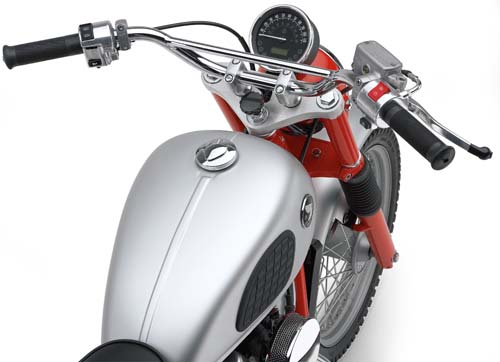
The funky-looking Dream with leftover German styling best suited to a Shriner’s parade was soon gone from the catalog. That left the CB72 Hawk 250 and CB77 Super Hawk 305, identical save for cylinder bore, and the CL72 Scrambler 250, superseded in ’65 by a 305 version. The Hawks with their low, flat handlebars and chrome-sided fuel tanks had a sporty European flair and were favored by the zip-back boot set, but it was the Scramblers and their go-anywhere, do-anything attitude that really found a home in America. Just as the bike was hitting showrooms its rugged dependability was underscored with a record Baja run from Tijuana to La Paz (see Baja Bound, pg. 43). Soon the Beach Boys, no less, were singing the Scrambler’s praises. The “groovy little motorbike” in 1964’s Little Honda that could “climb hills like a Matchless” had to be a CL72, not a step-through 50 as portrayed in the later, lamer Hondells cover version. Roy Rogers, King of the Cowboys, rode a Scrambler, rifle scabbard attached to a fork tube. You can’t get much more American than the Boys and Roy.
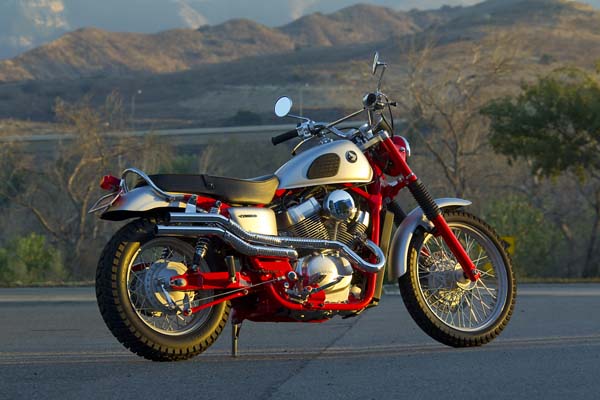
Turning a brand-new RS750 Shadow into a ’60s-style CL750 Scrambler was more an exercise in cosmetics than full-on surgery. “Before the build began, I got out my old snapshots, some bike magazines from back in the day and I went on the Internet, immersing myself in Honda Scramblers,” says Berg. “But when I began construction, I never looked at shots of the old bikes again. I was after the feel, the flavor, of a Scrambler, not an exact replica.”
Signature component was the high-rise exhaust system with its multilouvered heat shields. To allow the pipes to tuck in properly, Berg took about an inch-and-a-half out of each plastic side panel and rearranged the electrics beneath. Likewise the shock mounts were narrowed up so the Progressive Series 14s could be moved inboard. The rider’s footpegs were moved rearward about 5 inches, and Berg ground down and smoothed over some welds; otherwise, the frame is as it left the Honda factory.
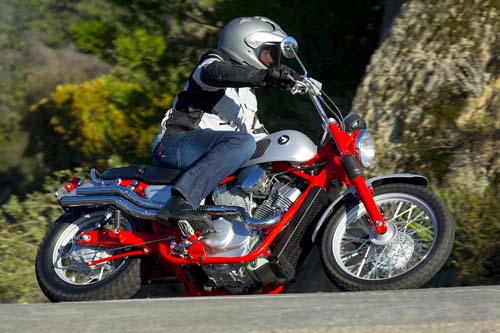
Up front, the stock fork was shortened about three-quarters of an inch, rubber gaiters cover the exposed tubes and that’s the stock RS fender mounted between the fork legs. Berg concentrated on getting the headlight ears just right and really wanted to mount an old-style headlight shell/speedometer combo. “It just didn’t look right with the wider fork, plus I wanted to keep all the stock speedo’s functionality and its warning lights, so I fitted a Triumph repop headlight and moved the stock clock down three-quarters of an inch,” he says.
Handlebars are stock with a crossbrace welded on and rechromed. To clean up the area, electrical wiring was run inside the bars. A nonfunctional friction damper knob adds an old-school vibe to the fork crown (no letters, please, from CL nutters pointing out that Scramblers actually had proper shock-style steering dampers).
From the steering head back, more Scrambler sampling. Believe it or not, that’s the stock RS gas tank, just with a faux seam added down the middle, rubber knee grips sourced from a Japanese-model GB250 and reproduction “Wing” badges screwed on. The seat uses the RS pan but with foam filling in the usual dip to more closely resemble the flat (and comfortable) ironing boards of old. Rear fender is, again, stock RS750, bobbed and adorned with a genuine 1965 Honda taillight brought up to date with an LED bulb. True to his South Dakota farmboy roots, Berg likes to re-use and repurpose whenever possible, so the chromed rear grabrail started life as one of Cobra’s accessory bumper guards for a Kawasaki Vulcan fender.
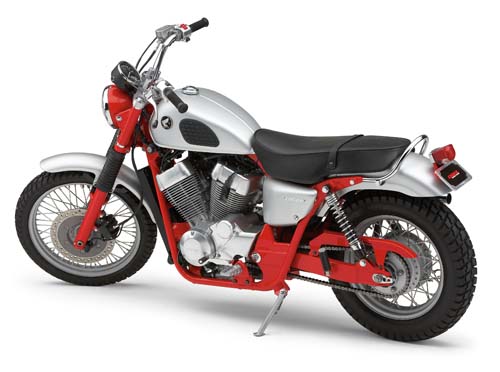
Keeping with that theme, hubs, brakes and wheels are straight from the RS, though the latter were dechromed before being powdercoated silver-gray. Finding a dual-purpose tire for the 19-inch front was a piece o’ cake; not so with the 16-inch rear—a 130mm Duro HF904 with a suitably blocky tread pattern was eventually found.
Final piece of the Scrambler transformation was paint. Early Honda expert Bill Silver was enlisted to track down the correct codes for the red-orange on the frame, fork, triple-clamps and headlight, plus the trademark Cloud Silver for the bodywork. A hi-temp silver for the cases and cylinders put a spotlight on the motor, formerly a stealthy black.
The finished product is a jaw-dropper, as you can see for yourself at the remaining International Motorcycle Shows, where, interestingly, it will be on display in the Honda booth. Should we read anything into that placement? “Hey, I just wanted to build a modern Scrambler with ties back to one of Honda’s iconic models,” says Berg. “What, if anything, happens from here isn’t up to me.”

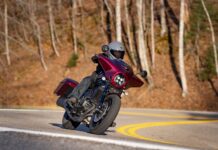





This is an awsome bike. I had a red and gray, CL77 when I was a kid in 1967. I loved that bike. I Think Denny combined the best of two ideas in this creation. A masterpiece Denny!
I’ll buy one if available. I had a 1973 CL350 until 2007, and it turned heads. Everywere I go people shared memories or ask about the bike. The RS750 recreates the style and I love it.
HONDA: Bring it on!
Cool! Brings back a lot of H.S. memories. I didn’t notice if it had “Snuff-or-Nots” installed… ;o)